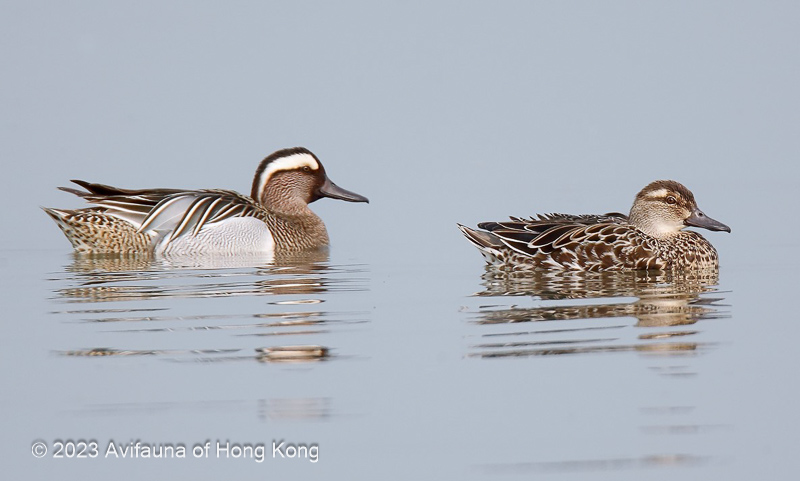Garganey Spatula querquedula 白眉鴨
Category I. Passage migrant, mainly autumn, with small numbers in winter; largely restricted to Deep Bay area.
IDENTIFICATION

Apr. 2011, Michelle and Peter Wong. Male (left), female.
37-41 cm. Slightly larger bill and body size than Eurasian Teal. Male has dark brownish head with striking broad white supercilium that curves down to reach nape, greyish flanks, brown chest and long black and white scapulars. Female differs from Eurasian Teal in more contrasting head pattern with whitish supercilium and cheek stripe separated by dark eye stripe, whitish loral spot, pale throat and by lack of pale side to the tail.

Mar. 2023, Sarawak, Malaysia. Dave Bakewell. Male.
In flight speculum has broad upper and lower borders; male outer wing is paler and forewing is pale greyish (also in eclipse).

Mar. 2023, Sarawak, Malaysia. Dave Bakewell. Female.
In flight female speculum usually has broad upper border and secondaries have broad white tips; compared to Eurasian Teal both sexes have greater contrast on underwings.
VOCALISATIONS
Appears to vocalise only rarely in autumn and winter, but in spring males can occasionally be heard giving a highly distinctive throaty clicking.
The female utters a call similar to Mallard but thinner and higher pitched.
DISTRIBUTION & HABITAT PREFERENCE
Most records have been from the Deep Bay area with small numbers noted at nearby Long Valley (highest count 15) and Kam Tin (highest count 12). Birds can be seen in both freshwater and brackish ponds, as well as in the intertidal areas, which is where the largest counts are generally made.
Elsewhere, up to 49 were recorded at the former airport at Kai Tak during 1978 and 1979, and up to 110 were recorded in spring at Ting Kau in the period 1977-79. More than other duck species, Garganey is seen on active migration over the sea, with counts of up to 50 birds over southern waters. There are also scattered coastal records from Shuen Wan, Tolo Harbour, Cape D’Aguilar (during tropical storms), Shek O, Lantau, Chek Lap Kok and Sai Kung, with only two records from the reservoirs.
OCCURRENCE
Garganey is mainly a passage migrant through Hong Kong, mostly in autumn, with small numbers remaining to spend the winter. Figure 1 illustrates the pattern of occurrence during the year.
In autumn the earliest birds are usually recorded in the final week of August, though occasionally as early as the second week of the month. The third week of September marks the beginning of peak passage, which lasts to mid-October and generally peaks in the first week of that month. The highest counts 715 on 27 September 1996 and 710 on 7 October 1995, although the highest count this century is 600.
Passage continues in force to the end of the month, after which there is only one three-figure count, which occurred in 1976. Those present from the first week of December appear to constitute the small wintering population. Most winter peak counts are in the range 10-60, with the highest being 126 on 5 January 2007.
Spring migrants are noted from about the second week of February and peak in the second half of March and first week of April. Although the maximum spring count is 410 on 7 April 1979, the highest spring count this century is somewhat lower, at 192. Numbers tail off during the second half of April. There are only three double-figure counts, all 50 or fewer, after the first week of May; this century, however, only single figure counts have been reported in May. Presumed over-summering birds are occasionally reported.
The mean of peak autumn counts during the 1990s was 432, while that in the subsequent two decades was approximately 250, suggesting a decline in numbers, especially in the context of increased observer coverage and record submission in recent years.
Vaughan and Jones (1913) stated that Garganey occurred in the Pearl River Delta on both spring (until 17 April) and autumn passage (until 12 November) but that numbers varied considerably. Dove and Goodhart (1955) listed a small number of records from April and October, and one for sale in February. Macfarlane and Macdonald (1966) listed, in addition, four April records of up to 200 birds and one September record.
BEHAVIOUR, FORAGING & DIET
Forms large groups in intertidal areas where it is easily observed but is rather more unobtrusive in marshy habitat with emergent vegetation. Feeds by dabbling and head-dipping, but rarely upends (which Eurasian Teal does frequently).
RANGE & SYSTEMATICS
Monotypic. Breeds across much of Eurasia between 40oN and 65oN, as far east as Hokkaido and Kamchatka; winters central and east Africa, the Indian subcontinent, southeast Asia through to Kalimantan and west Papua (Carboneras and Kirwan 2020). In China breeds in northern Xinjiang and the northeast, and winters in the southwest and coastally in the south including Taiwan and Hainan (Liu and Chen 2020).
CONSERVATION STATUS
IUCN: Least Concern. Population trend decreasing.
Figure 1.

Carboneras, C. and G. M. Kirwan (2020). Garganey (Spatula querquedula), version 1.0. In Birds of the World (J. del Hoyo, A. Elliott, J. Sargatal, D. A. Christie, and E. de Juana, Editors). Cornell Lab of Ornithology, Ithaca, NY, USA. https://doi.org/10.2173/bow.gargan.01
Dove, R. S. and H. J. Goodhart (1955). Field observations from the Colony of Hong Kong. Ibis 97: 311-340.
Liu, Y. and Y. H. Chen (eds) (2020). The CNG Field Guide to the Birds of China (in Chinese). Hunan Science and Technology Publication House, Changsha.
Macfarlane, A. M. and A. D. Macdonald, revised by Caunter, J. R. L. and A. M. Macfarlane (1966). An Annotated Check-list of the Birds of Hong Kong. Hong Kong Bird Watching Society, Hong Kong.
Vaughan, R. E. and K. H. Jones (1913). The birds of Hong Kong, Macao and the West River or Si Kiang in South-East China, with special reference to their nidification and seasonal movements. Ibis 1913: 17-76, 163-201, 351-384.

